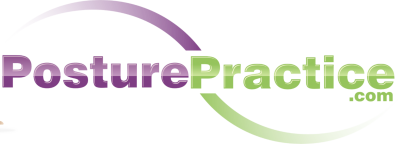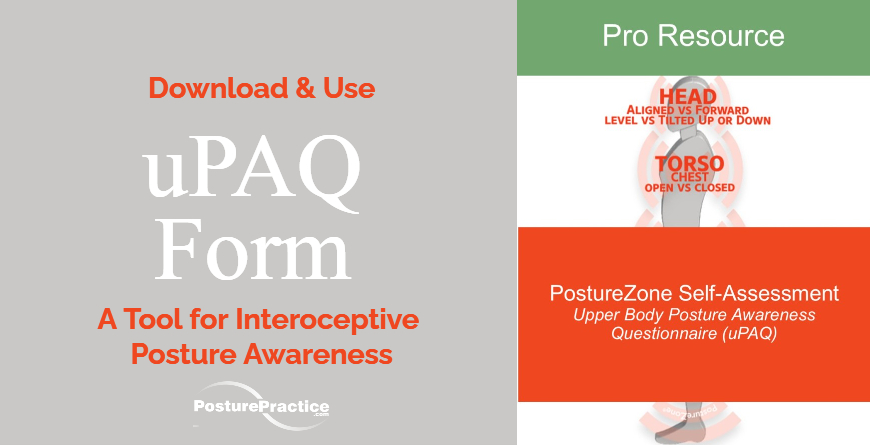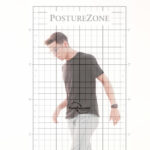uPAQ: A Tool for Interoceptive Posture Awareness & Consciousness
Interoception is the subtle sense that link the body and brain, our mind and our emotions. Coined in 1906 by pioneering biologist and Nobel Prize winner Charles Sherrington as a way to describe “sensations from the interior of the body, especially the viscera” (Sherrington, 19061), research now shows this hidden sense has been massively undervalued, and in truth plays a vital role shaping attitude, mood and overall health.
The potential value of low tech neuromusculoskeletal (NMS) care is similarly undervalued… for similar reasons, both biologic and behavioral. In Interoception: A Multi-Sensory Foundation of Participation in Daily Life, Schmidt and Shoen describe interception as a “multidimensional, complex system representing the integration of multiple senses” with moment by moment homeostatic roles that “manage physiological stressors reflective of allostatic processes”2.
A Physical Complement to Cognitive Behavioral Therapy
Pain and biomechanic compromises are potent physiologic stressors. Especially when they endure, their cumulative effects create negative cycles of function and structure, cognition and behavior, that together spiral downward.
Supported by rapidly accumulating evidence based guidelines for pain, Cognitive Behavior Therapy attempts to reverse this spiral by focusing on the mental side of the equation, our human cognition. I believe this is a good thing, but in large part CBT neglects the effect of cognition and attention on the subtle physical functions facilitating this downward spiral. Which is why especially in our modern stressed tech-flexed life, qualitatively strengthening a person’s internal posture and body awareness and their externally expressed postural control is a valuable missing link for NMS care.

Addressing the body-mind pain spiral is why we began working with doctors and therapists to develop a tool to benchmark and track interoceptive posture awareness. This was a step towards a more granular posture consciousness. Last month, we introduced uPAQ, the Upper body Posture Awareness Questionnaire as a free download for neuromusculoskeletal pros striving to improve pain-free, functional movement.
uPAQ is an easy to integrate, three-question form designed to build interoceptive somatic awareness. It was created for clinicians and health practitioners to help those they care for build greater interoceptive awareness. Laypeople are also finding the uPAQ an engaging way to improve posture.
The Problem with Quick Fixes for Bad Posture
The long-standing challenge with posture assessment has been the complexity of bipedal posture. Plus, when clinical issues develop that are posture related, or even attributed to posture, the problem usually is established from how the individual moves in everything they do.
Clinically relevant posture observations are exceedingly difficult to discern because posture is as unique as a fingerprint. Countless possible patterns exist for humans to balance the mass of their body by moving different combinations of individual joints, each with a wide range of possible arcs of motion.
The nearly infinite combination of subtle interactions between each person’s mind and body complicates the wide range of their unique genetic body. Plus, common structural variances can be insignificant, but ethically challenged practices can exaggerate the issue with fear based communications.
Clinicians and healers of many professions find that the uPAQ (Upper body Posture Awareness Questionnaire) addresses this challenge by simply having individuals focus on their subjective feeling of a somatic subtlety and document that feeling. It’s about empowering people by encouraging them to listen to their bodies.
When coupled with a simple posture picture, the uPAQ sets a proprioceptive and interoceptive baseline. It’s snapshot of how someone internally feels, linked to how they externally appear. We call this linkage of perception to reality P2R, and it’s a foundation for clinical frameworks seeking to create, enhance and document an individual’s internal awareness and control of their body’s unique external physicality. In other words, how they stand, sit and move in everything they do.
All Motion begins with Posture, All Motion Ends with Posture
The uPAQ makes posture real and personal. Using the PostureZone® framework to standardize observation and communication, interoceptive perception improves when someone focuses on, and then personally documents the subjective feeling of a subtlety. For example, focusing attention on relative head tilt in a perceived neutral position reliably improves the perceived value of the benefits of efforts to address that observation.
It’s the application of MindBody to BodyMind, and it’s arguably why compliance for other advice for beneficial lifestyle behaviors improves as well. Which is why for sustainably changes to behavior, we urge clinical communications that blend in office therapies with at home short duration exercise and self care.
Battle the Pain Cycle: Get Posture Conscious
NMS health pros as well as other healers have discovered StrongPosture® exercise is uniquely designed to elegantly integrate neuromuscular attentional focus and motor control exercise towards greater interoceptive posture awareness. Even though the functional consequences of structural subtleties are be hard or impossible to tease out, by providing a foundation of awareness, communication and action we can help people strengthen posture awareness to be more accurate-to-reality, and train subtleties of motor control towards that objective reality as well.3
We’re extending the free uPAQ download, so print it out and see for yourself how people react when they’re focused on their body’s posture. Whatever your choice of in-office therapeutic intervention, systematically correlating simple but subtle observations with interoceptive awareness of subtle somatic patterns can strengthen that awareness towards accuracy, within their unique sets of pain-free functional ranges of motor control.
1 Sherrington, C. S. (1906). The Integrative Action of the Nervous System. Yale University Press.
2 Schmitt, C. M., & Schoen, S. (2022). Interoception: A Multi-Sensory Foundation of Participation in Daily Life. Frontiers in Neuroscience, 16.
3 Weiniger, S; Stand Taller Live Longer: A Posture and Anti-Aging Strategy, 2008
Looking for ways to integrate these concepts with patients?
- Get the free Upper body Posture Awareness Questionnaire (uPAQ). This is a tool for NMS pros to build interoceptive posture awareness (Click here to download)
- Subscribe to 7SSP – the at-home patient exercise rehab program. Practitioners have unlimited access for their clientele. (Find out more)






















